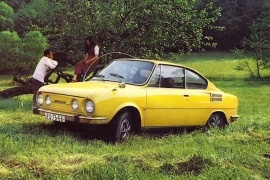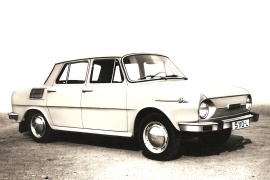SKODA 100 series Models/Series Timeline, Specifications & Photos
First production year: 1969
Engines: Gasoline
Back in the '70s, Skoda was a modest carmaker from Czechoslovakia, and it aimed the East European customers, who were trapped behind the Iron Curtain.
Some particular vehicles made history, such as the 110R Coupe, the Porsche of the East. The fastback coupe was a sportier version of the regular sedan Skoda S100, which was based on the 1000MB. Its country needed Western money, so they had to export it to the rest of Europe and get some GBP or Deutsche Marks back. The 110R was just the right car to get that. Skoda promoted it in the U.K.'s RAC Rally, where it obtained several class wins.
At the front, the car featured four round headlights and a flat panel without any grille. That was because the water-cooled engine was in the back. Its fenders and doors were flush, and the car's profile was aerodynamically enhanced. Skoda installed chromed, metallic bumpers with rubber shock-absorbers on them.
The interior was elaborated for its times. At the front, it featured two bucket seats. Between them, Skoda installed a floor-mounted gear-stick. A center stack connected the dashboard with the center console, with a radio on it as an option in front of it. The flat dashboard offered a glove-box in front of the passenger and five dials. In the back, there was a bench for two passengers, especially children.
Skoda installed a 1.1-liter, longitudinally-mounted engine. It was paired to a four-speed manual gearbox, and that was the only option. Unlike the sedan version, the 110R's four-pot was upgraded to offer slightly more power.
Skoda introduced the 100 Series in 1969 as a replacement for the 1000 range and helped the Czech carmaker selling over one million units in just eight years.
The short time passed did not yet heal the Prague Spring's wounds when Czechoslovakia raised against the communism system, but the factories had to resume their work. Skoda already had plans for the new car and kept its promises.
Skoda's front fascia sported a metallic panel and two round headlights at the front. Its radiator was in the back, so it didn't need a grille to cool-it. Like its MB1000 predecessor, the MB100 sported a chromed metallic bumper with vertical rubber protections. In the back, the side air-intakes to cool the engine were above the rear wheel-arches. In the back, under the horizontally mounted taillights, the carmaker installed a wide and narrow grille that helped to cool the engine.
Since there was no engine or transmission tunnel, the carmaker was able to create a roomy interior fit for five passengers. Its front-mounted luggage compartment was not very big, but it was good enough for a few suitcases. The carmaker installed a slightly curved dash panel, with an instrument cluster mounted behind the steering wheel. Its wide speedometer was flanked by few other gauges for fuel, coolant temperature, oil pressure, and ammeter.
Skoda built the MB100 with the same idea as to its predecessor. The 1.0-liter or the 1.1-liter unit was placed longitudinally in the back and sent the power to the rear wheels via a four-speed manual gearbox. Its independent suspension in all corners transformed the Czechoslovakian car into one of the most comfortable family sedans built in Eastern Europe.

